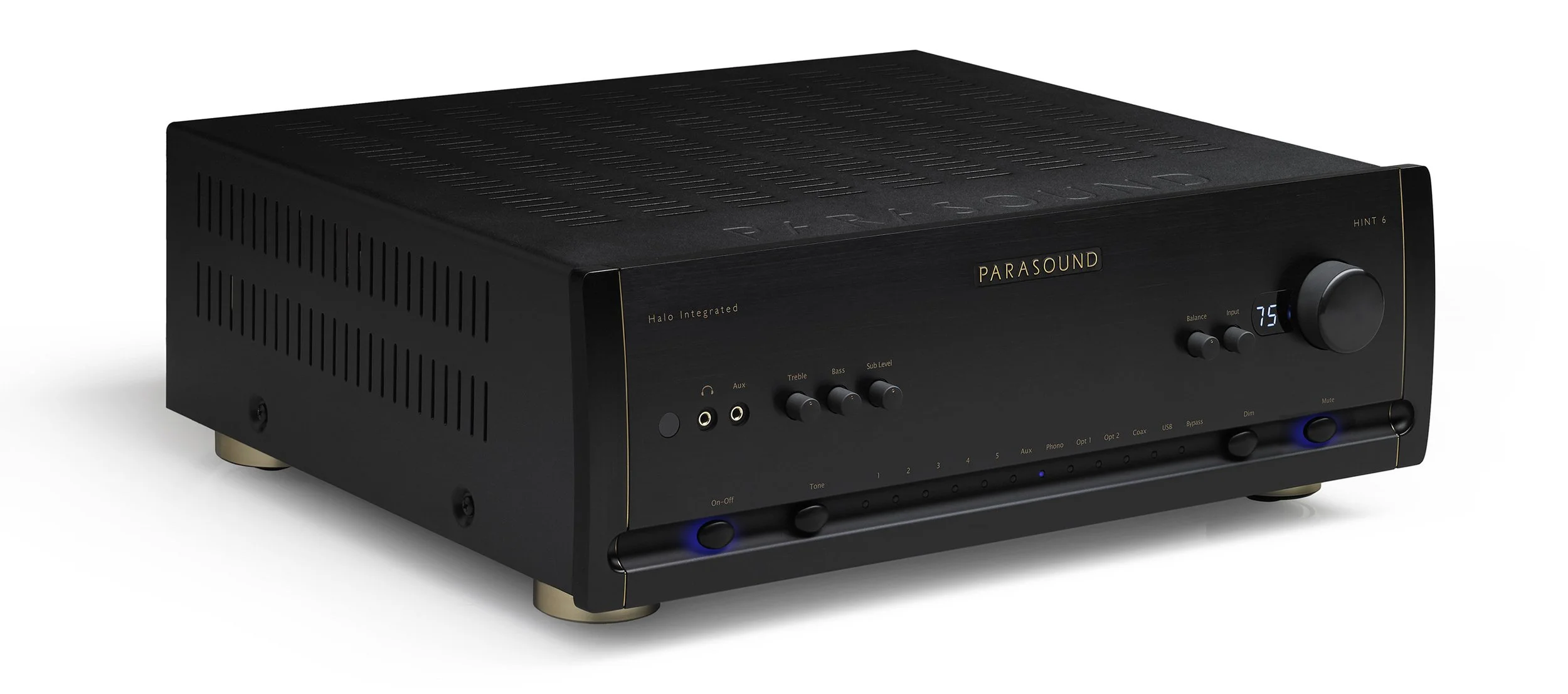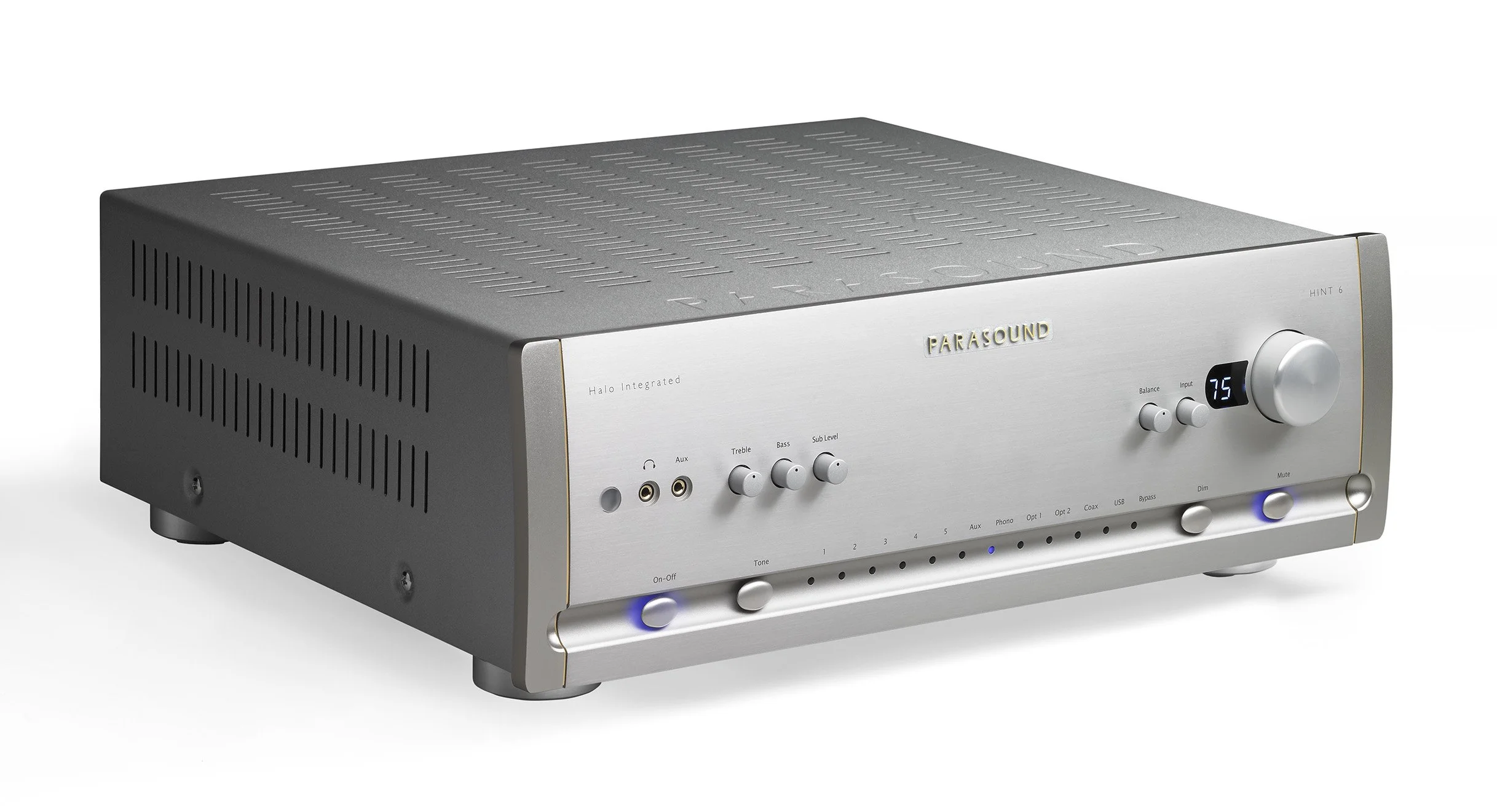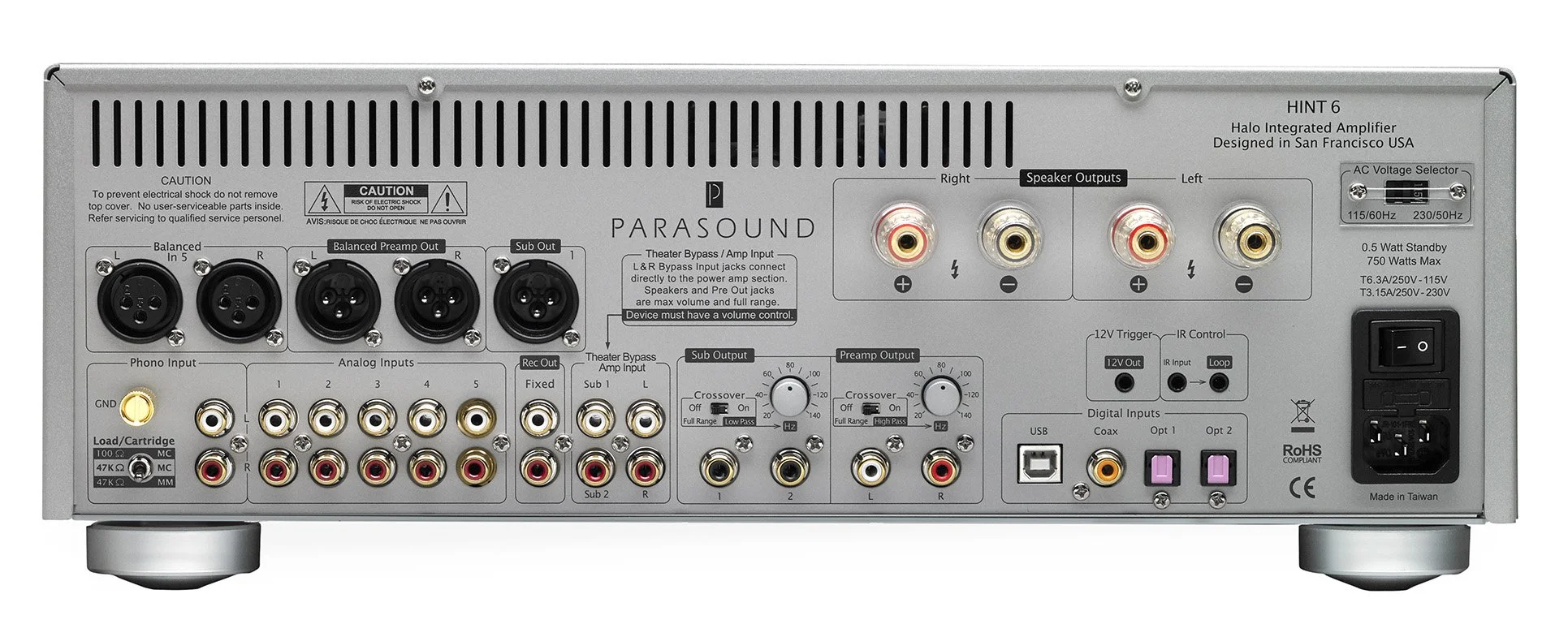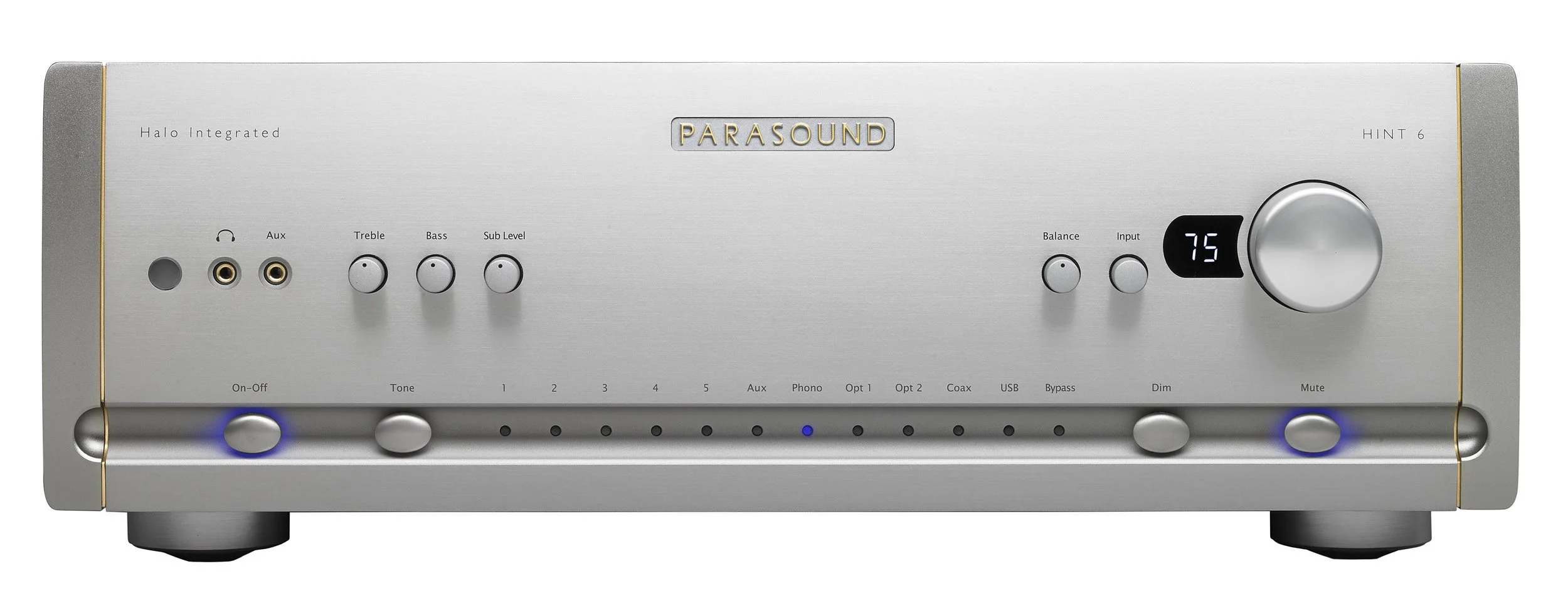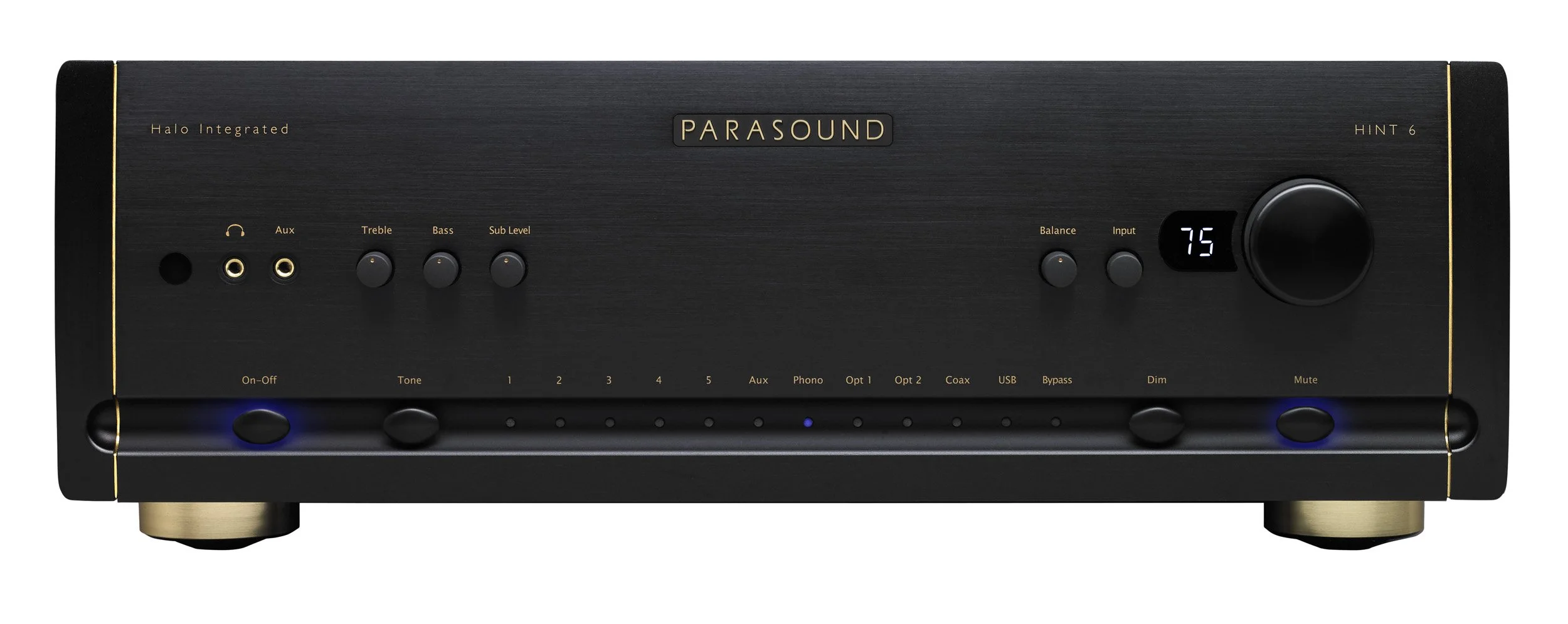PARASOUND HINT 6+ INTEGRATED - REVIEW
PARASOUND HINT 6+ INTEGRATED
San Francisco based Parasound has been making highly rated amplifiers and preamps for decades now, with many of their products being affordable for a wide range of enthusiasts. Their designs are often feature packed, and they are all built to a high standard in Taiwan. The company offers warranties on all their products, and their reputation for customer support is excellent.
Amplifiers are where Parasound made their name, with well known designer John Curl contributing circuit designs early on. Parasound kindly sent their Halo Hint 6 integrated amplifier in for review, and it is an attractively priced audio Swiss Army Knife, covering just about every base with its rich set of features. This is the second iteration of the Halo Hint 6, with the original in circulation from 2014 to 2018.
Parasound took the opportunity to make numerous design and hardware improvements for the Hint 6, released in 2019. Some of the modifications include a Burr-Brown, analog resistor ladder volume control (my preferred implementation), an updated USB receiver, additional digital inputs, an upgraded solid aluminum volume knob, and an updated internal phono preamp. In addition they made some thoughtful improvements, such as a dimmable display, volume settings that can be programmed as favorites, and cleaner cosmetics. Yes, a full function remote control is included as well. The Halo Hint 6 retails for $3199.
The Hint 6 weighs in at 33 lbs, and offers 160 watts of class A/B power into 8 ohms, more than enough juice to get the party started. The amplifier section is indeed a John Curl design. There is also a headphone amplifier, a USB input, a MM and MC phono stage, both RCA and XLR analog inputs, a subwoofer output, and interestingly, tone controls, which can be bypassed. The Hint 6 is attractive in appearance and the workmanship of the case work is very clean. Like all, or most Parasound products, the amp is available in black or silver. Our unit arrived with silver casework.
Set Up & Listening:
The Halo Hint 6 was inserted into a system consisting of a Sonore microRendu streamer, a Rega Planar 6 turntable, with Audio Art Cable wire. The Hint 6 drove two pairs of speakers during our time with the amp, the Scansonic MB1 B (Review Link), and the Acelec Model One (review forthcoming), both excellent stand mount monitors of medium efficiency.
Our observations will be an overview of performance with both speakers, as they turned out to be excellent matches for the Parasound. No special tweaks were used aside from an Audio Art Cable power cord, and the system was plugged into an Audience power conditioner. The Halo Hint ran surprisingly cool to the touch, even when left on 24/7.
We decided to give vinyl a go to start, to get a handle on the Hint Halo 6’s onboard phono preamp. We spun a US A&M pressing of Fairport Convention’s1968 self-titled album, a mid 70’s Blue Note pressing of The Best Of Herbie Hancock, and Abba’s The Singles: The First Ten Years. After just one side of play, it was clear the Hint 6’s phono stage was up to the test. In fact, it bettered all three of the modestly priced standalone phono preamps we had in house.
There was plenty of flesh on the bone, great texture, and tonally everything fit into place. Hancock’s piano had nice percussive presence, and the horns were beautifully rendered. The flow of the bass and drums was well preserved, and the “live” feeling of the ensemble was palpable. The internal phono stage is more than good, it is very good, and offers such high value, it should preclude using an external unit.
We focused the rest of the time with the Halo HInt 6 on putting the internal DAC through its paces. We streamed everything from CD rips to DSD from our local library. Spoiler, the Hint 6’s internal DAC module is no casual add on, it is high class in every way. In our opinion you would have to spend well over a grand for an external DAC that can compete.
Our SACD rip of Mobile Fidelity’s DSD remaster of Santana’s self-titled first album from 1969 was a true delight. The Halo Hint 6 was able to showcase the conservative recording techniques Columbia used at the time for rock albums, with hard panning, lots of isolation, and room sound. However, it served Santana well, with all the instruments and the fantastic vocals by Greg Rollie all being rendered with precision and superb texture.
The self-titled debut, and the follow up, Welcome To The North, by The Music, a band we adored in the 2000’s, had incredible energy and adrenaline. The Halo Hint 6 made these two albums, both ripped CDs, into sonic spectaculars, with the Northern U.K. band’s blend of subtle electronica, grunge, psychedelia, and beats distilled into a tasty brew. Having seen the band live, we were thrilled at how the Hint 6 got everything right, especially the energy the band brought to the stage.
The curiously named I Draw Slow, a contemporary band from Dublin, Ireland, makes beautiful, sometimes ethereal folk music. They blend elements of Celtic, Americana, and even classic 70’s West Coast laid back pop. Their self-titled, 4th album has just been released, and it is a stunner. It is a beautiful pastoral record, and the Hint 6 brought all the colors of Autumn inherent in this 24 bit, 48 Khz download. We could picture the leaves turning brown and falling from the trees as the album played on. All their albums are available on Bandcamp.
Another new discovery, folk rock band Jennie Ox, also a 24 bit download, mix very early Joni Mitchell earnestness with baroque and psychedelic touches to achieve a very organic, retro sound. Yet, it is somehow still modern sounding. The debut EP, Duck Season, is a 5 song tour de force that quickly becomes an earworm. The band’s secret weapon is mixing to analog tape, and the Parasound absolutely let us hear that tape goodness, there was no mistaking it!
Going back in time again, we called up an album we have previously used for reviews, Let’s Live For Today: The Complete Recordings, by The Living Daylights. Reading the liner notes more carefully, we discovered that the majority of their recordings were never released, just a handful of singles. Out of the 23 tracks here, 20 have never seen the light of day, so to speak. Their version of “Let’s Live For Today”, a hit for The Grass Roots, is a knock out, as are some of the originals, and several Beatles covers. The Parasound helped unlock this treasure chest of late 60’s acid rock with lovely precision. The CD mastering is immaculate, with both mono and stereo mixes for a number of tracks.
There were really no ergonomic issues to find fault with. The Halo Hint 6 had a very low noise floor, did not run hot, and was fully remote controllable. The amp had full grip on the speakers, with no obvious sonic gaps. As a bonus, the Halo Hint 6 is a handsome addition to any system.
Conclusion:
I really enjoyed the Parasound Halo Hint 6. I mean really enjoyed it. It exudes class, sounds wonderful, and is built to a high standard. I also really like the price. For $3200 you get an amp designed by John Curl that will drive any speaker, a DSD DAC, a phono preamp, and numerous other bells and whistles.
If shopping for an integrated amplifier in the $3000 range, we honestly can’t think of another product we would recommend over the Parasound Hint Halo 6. You need tone controls to sculpt your sound? A subwoofer output? Preamp output? Balanced connections? A DAC with numerous digital inputs and Moving Magnet and Moving Coil Phono preamp? All boxes checked, and even more.
The amplifier itself was an excellent match for the Scansonic and Acelec monitors. As with any other high quality component, better cables will make a difference, as would a high quality power cord. Other than that, the Hint Halo 6 is a plug and play device.The last word is the Hint Halo 6 is astounding value, and a great integrated amplifier.
Parasound Halo Hint 6 Integrated amplifier: $3199
Product Information page:
https://parasound.com/hint6.php
Preamp and DAC Features
ESS Sabre32 Reference DAC (ES9018K2M)
Asynchronous USB 2.0 supports PCM up to 384kHz/32-bit
USB input decodes Native DSD64, DSD128, DSD256 and DoP DSD
Coax and optical inputs accept PCM up to 192kHz/24-bit
Analog bass management with high & low pass crossovers
Front panel subwoofer level control
Dedicated high current headphone amplifier
Phono input for MM, MC and MI with 100 Ω or 47k Ω load
Front panel Aux input with automatic +12 dB gain stage
5 pairs RCA line level Analog inputs
1 pair XLR balanced Analog input
Balanced XLR and RCA left and right preamp outputs
1 balanced XLR and 2 RCA subwoofer outputs
Bass & treble controls with relay bypass from remote or front panel
Power Amp Features
160 Watts x 2 @ 8 Ohms (RMS, both channels driven)
240 Watts x 2 @ 4 Ohms (RMS, both channels driven)
Power amp circuit topology designed by legendary John Curl
High bias class A/AB operation
Dual-mono power supply and power amplifier
MANUFACTURER
Parasound Products, Inc.
2250 McKinnon Avenue
San Francisco, CA 94124
parasound.com
Sales@parasound.com
AKRM
